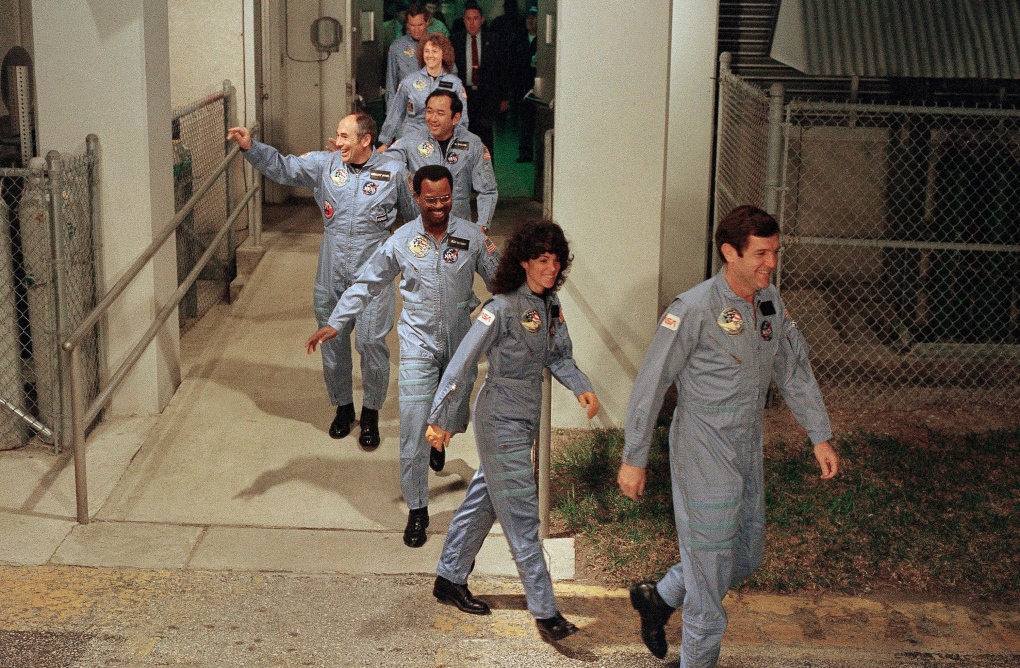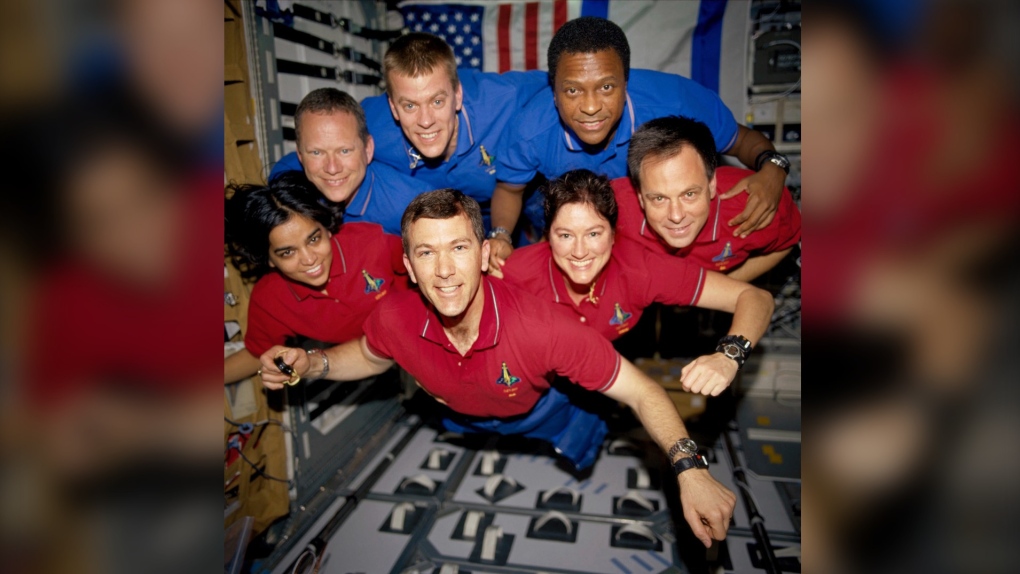The three space tragedies that led to NASA's day of remembrance
In an incredible coincidence, the four days between Jan. 27 and Feb. 1 include anniversaries of three tragic events that changed the NASA space program forever.
CTV News anchor Mustumi Takahashi spoke with former astronaut Julie Payette about the Apollo 1, Space Shuttle Challenger and Space Shuttle Columbia disasters and how they affected space travel.
NASA commemorates the tragedies the last Thursday of every January.
WATCH the full interview above.
Apollo 1, January 27, 1967
A fire on the launch pad at Cape Kennedy during a pre-flight test for Apollo resulted in the deaths of astronauts Virgil Grissom, Edward White and Roger Chaffee as flames swept through the command module.
NASA says that "technical and management lapses led to the accident."
 In this undated photo made available by NASA, from left, veteran astronaut Virgil Grissom, first American spacewalker Ed White and rookie Roger Chaffee, stand for a photograph in Cape Kennedy, Fla. During a launch pad test on Jan. 27, 1967, a flash fire erupted inside their capsule killing the three Apollo crew members. (NASA via AP)
In this undated photo made available by NASA, from left, veteran astronaut Virgil Grissom, first American spacewalker Ed White and rookie Roger Chaffee, stand for a photograph in Cape Kennedy, Fla. During a launch pad test on Jan. 27, 1967, a flash fire erupted inside their capsule killing the three Apollo crew members. (NASA via AP)
Shuttle Challenger, January 28, 1986
Seventy-three seconds into the Space Shuttle Challenger's STS-51L mission, an "explosive burn of hydrogen and oxygen propellants that destroyed the External Tank and exposed the Orbiter to severe aerodynamic loads that caused the complete structural breakup," according to NASA's report on the disaster.
Shuttle commander Francis R. Scobee, pilot Michale J. Smith, mission specialists Judith A. Resnik, Ronald E. McNair and Ellison S. Onizuka all died, as did payload specialist Gregory B. Jarvis and teacher Sharon Christa McAuliffe.
A lengthy investigation found the cause of the disaster was an o-ring failure in the right solid rocket booster, which was aggravated by extreme cold weather in Florida before the launch, NASA said.
 FILE - In this Jan. 27, 1986, file photo, the crew for the Space Shuttle Challenger flight 51-L leaves their quarters for the launch pad at the Kennedy Space Center in Florida. Mission Spl. Ronald McNair, center, was only the second African American chosen to go to space. He died in the Challenger launch. The documentary "Black in Space: Breaking the Color Barrier" is scheduled to air on the Smithsonian Channel on Monday, Feb. 24, 2020, and examines the race to get black astronauts into space. (AP Photo/Steve Helber, File)
FILE - In this Jan. 27, 1986, file photo, the crew for the Space Shuttle Challenger flight 51-L leaves their quarters for the launch pad at the Kennedy Space Center in Florida. Mission Spl. Ronald McNair, center, was only the second African American chosen to go to space. He died in the Challenger launch. The documentary "Black in Space: Breaking the Color Barrier" is scheduled to air on the Smithsonian Channel on Monday, Feb. 24, 2020, and examines the race to get black astronauts into space. (AP Photo/Steve Helber, File)
Columbia, February 1, 2003
The Columbia STS-107 lifted off on Jan. 16, 2003 and suffered a catastrophic failure on Feb. 1, 2003 upon reentry into the earth's atmosphere.
The failure was caused by a break that occured during launch when falling foam from the external tank struck the reinforced carbon panels on the underside of the left wing, according to NASA.
Rick D. Husband, William C. McCool, Michael P. Anderson, David Brown, Kalpana Chawla, Laurel Blair Salton Clark and Ilan Ramon were killed 15 minutes before the Columbia was scheduled to touch down at Kennedy Space Center.
 This undated photo released in June 2003 provided by NASA shows STS-107 crew members aboard the Space Shuttle Columbia. On Feb. 1, 2003, the seven crew members were lost as the Columbia fell apart over East Texas. This picture was on a roll of unprocessed film later recovered by searchers from the debris. From the left (bottom row), wearing red shirts to signify their shift's color, are mission specialist Kalpana Chawla, commander, Rick D. Husband, mission commander Laurel B. Clark and Ilan Ramon, payload specialist. From the left (top row), wearing blue shirts, are mission specialist David M. Brown, pilot William C. McCool, pilot; and payload commander Michael P. Anderson. (NASA via AP, File)
This undated photo released in June 2003 provided by NASA shows STS-107 crew members aboard the Space Shuttle Columbia. On Feb. 1, 2003, the seven crew members were lost as the Columbia fell apart over East Texas. This picture was on a roll of unprocessed film later recovered by searchers from the debris. From the left (bottom row), wearing red shirts to signify their shift's color, are mission specialist Kalpana Chawla, commander, Rick D. Husband, mission commander Laurel B. Clark and Ilan Ramon, payload specialist. From the left (top row), wearing blue shirts, are mission specialist David M. Brown, pilot William C. McCool, pilot; and payload commander Michael P. Anderson. (NASA via AP, File)
CTVNews.ca Top Stories

W5 Investigates A 'ticking time bomb': Inside Syria's toughest prison holding accused high-ranking ISIS members
In the last of a three-part investigation, W5's Avery Haines was given rare access to a Syrian prison, where thousands of accused high-ranking ISIS members are being held.
Trudeau Liberals' two-month GST holiday bill passes the House, off to the Senate
The federal government's five-page piece of legislation to enact Prime Minister Justin Trudeau's promised two-month tax break on a range of consumer goods over the holidays passed in the House of Commons late Thursday.
Irregular sleep patterns may raise risk of heart attack and stroke, study suggests
Sleeping and waking up at different times is associated with an increased risk of heart attack and stroke, even for people who get the recommended amount of sleep, according to new research.
California man who went missing for 25 years found after sister sees his picture in the news
It’s a Thanksgiving miracle for one California family after a man who went missing in 1999 was found 25 years later when his sister saw a photo of him in an online article, authorities said.
As Australia bans social media for children, Quebec is paying close attention
As Australia moves to ban social media for children under 16, Quebec is debating whether to follow suit.
Notre Dame Cathedral: Sneak peak ahead of the reopening
After more than five years of frenetic reconstruction work, Notre Dame Cathedral showed its new self to the world Friday, with rebuilt soaring ceilings and creamy good-as-new stonework erasing somber memories of its devastating fire in 2019.
Canada Post temporarily laying off striking workers, union says
The union representing Canada Post workers says the Crown corporation has been laying off striking employees as the labour action by more than 55,000 workers approaches the two-week mark.
Can't resist Black Friday weekend deals? How to shop while staying within your budget
A budgeting expert says there are a number of ways shoppers can avoid getting enveloped by the sales frenzy and resist spending beyond their means.
Montreal shopping mall playing 'Baby Shark' song to prevent unhoused from loitering
A shopping mall and office complex in downtown Montreal is being criticized for using the popular children's song 'Baby Shark' to discourage unhoused people from loitering in its emergency exit stairwells.


































